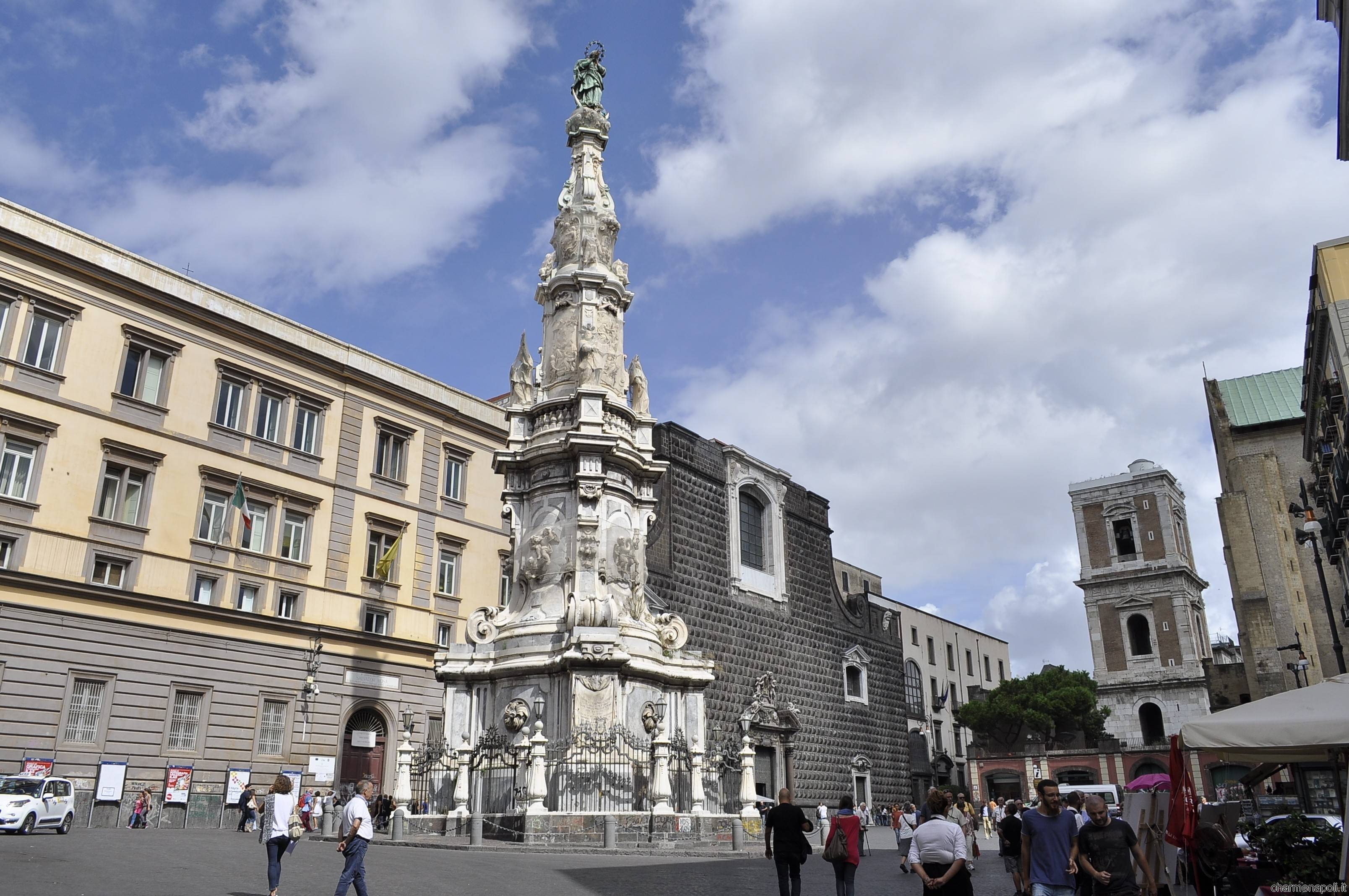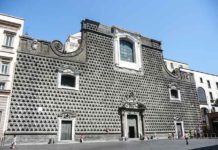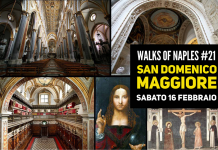Richly and sumptuous, the church of Gesù Nuovo, is a testimonial of Baroque art in Naples. It was commissioned by the Jesuits between 1584 and 1601 and built on the remains of the residence of Sanseverino family. It has a ashlar exterior, realized in 1470 by Novello from San Lucano. This church, with rich polychrome marbles and gorgeous decorations, presents an extraordinary collection of frescoes, paintings and sculptures by Francesco Solimena, Paolo De Matteis, Belisario Corenzio, Massimo Stanzione, Giuseppe Ribera, and Francesco Pagano. In Gesù Nuovo are kept the body of Saint Giuseppe Moscati and the rooms where the famous doctor from Benevento used to visit his patients.
In front of Gesù Nuovo, right in the heart of Decumani, centre of the Greek and Roman Neapolis, stands the church of Santa Chiara, built near the old western walls (today piazza del Gesù Nuovo), between 1310 and 1340, thanks to Robert of Anjou and the queen Sancha of Aragon.
The complex was erected on the remains of Roman therms dated to the I century A.C., whose findings can be seen under the foundations of the monastery and into the halls of Museum of Opera di Santa Chiara, showing also findings of Angevin period (XIV century).
This church, sober and impressive, hosts the tomb of King Robert of Anjou, behind the high altar, and the Bourbon funerary chapel. Near the entrance there is the grave of Salvo d’Acquisto, the officer who during World War II saved a group a civilians from the Nazis at cost of his own life. The monastery is famous worldwide for the splendid majolica cloister, made in 1742 by Domenico Antonio Vaccaro, who covered the entire structure and the 72 pillars with wonderful polychrome tiles, created by the Neapolitans “riggiolari” Donato e Giuseppe Massa.
Walking along the Decumani, there is another temple of Christian faith “made in Partenope”: the church of San Domenico Maggiore.
Built between 1283 and 1324 under King Charles II of Anjou on the remains of a X century church, it was restyled with Baroque taste, after being damaged by numerous earthquakes during the XV century. It is famous for the rectangular Sacristy, with marble floors and suggestive wooden details. It hosts 45 tombs of Neapolitan nobles, especially from the Aragona family. There are paintings by Tommaso De Vivo, Pietro Cavallini, Solimena and the marvellous high altar made by Cosimo Fanzago. In this church the poet Boccaccio studied law, but it was in a nearby church that the author of Decameron met the love of his life, Fiammetta, precisely in San Lorenzo Maggiore, set in via San Gregorio Armeno and “twin” of San Domenico because it was commissioned during the same period by King Charles of Anjou.
[charme-gallery]
Between 1600 and 1700 San Lorenzo was restyled according to Baroque taste, but the restorations of the XX century brought to light its original Gothic forms.
It has a striking 1700 façade, made by Ferdinando Sanfelice, with a XIV century marble portal, and it is enriched by numerous work of art, like the Tomb of Catherine of Austria, sculpted by Tino from Camaino (1323) and the Sant’Antonio Chapel, made by Cosimo Fanzago (1638).
In the Mercato area, where once stood the city walls, there is Santa Maria del Carmine. This church, with the highest bell tower of Naples (75 metres), was built at the beginning of 1300 on the foundations of a church where was venerated the icon of “Madonna Bruna”, a XIII century painting. There is the tomb of Conrad of Swabia, the last emperor of Sacred Roman Empire beheaded as a child in 1268 in piazza Mercato by King Charles of Anjou. In the cloister of this church was killed on 16 July 1647 the heroic fishmonger Masaniello. Every year on the 16th of July, for the Madonna del Carmine festival, the bell tower is “burnt” by the means of fireworks to recall a Saracen siege foiled by the Christians. At the entrance, there is a wooden miraculous Christ, who in 1439 lowered his head to avoid a shot exploded during a siege made by Alfonso of Aragon.
Another wonderful church is San Giovanni a Carbonara, set triumphantly on the top of a stair made by Ferdinando Sanfelice (1707). It was build in 1343 by King Ladislao of Durazzo, whose 18 metres tomb stands behind the high altar, supported by the four Virtues. Finished at the beginning of XV century, this church was heavily damaged during World War II and restorations took place along the XX century. It has a precious XV century majolica floor and hosts frescoes made in 1400 by Perrinetto from Benevento and Leonardo from Besozzo. The chapel Caracciolo di Vico has richly decorated marble floor and a wide lacunar dome.
[charme-gallery]
Last but not least, the church of San Filippo Neri, the inventor of the devotion of seven churches, called also “dei Girolamini”, set on via Tribunali. It is part of a complex hosting an important picture-gallery dating to the end of 1500. The project bears the signature of Giovanni Antonio Dosio, a Florentine just like the architect Ferdinando Fuga, who started the works in 1592.
Inside the church there are paintings by Pietro from Cortona and Guido Reni, sculptures by Bernini and a fresco made by Luca Giordano. It is also called “Domus Aurea” for its sparkling Baroque golden decoration. It hosts the tomb of philosopher Giambattista Vico, who worked into the famous library of the Oratorio, which counts more than 60.000 books.

 Italiano
Italiano














